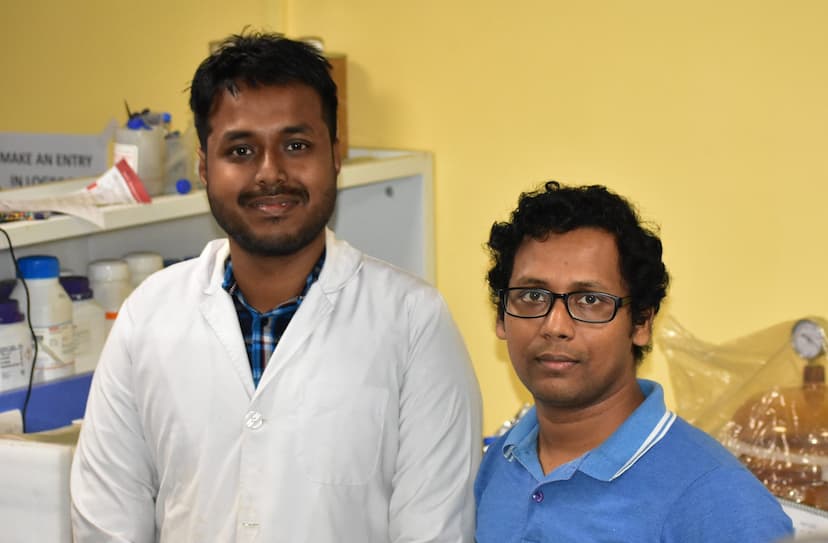IIT Guwahati research 2020: Great, solutions worked out

IIT Guwahati research, the research team of the prestigious institution developed hierarchically structured graphene oxide nanosheets that can selectively separate oily or aqueous contaminates from respective emulsions.
The researchers of Indian Institute of Technology Guwahati have developed a graphene-based superhydrophobic materials that can separate oil and water from both oil-in-water and water-in-oil emulsions respectively.


IIT Guwahati research paper has been authored by Dr. Uttam Manna, Associate Professor, Department of Chemistry, IIT Guwahati along with his research scholars Mr. Avijit Das, Mr. Kousik Maji, and Mr. Sarajit Naska.
Oil–water separation techniques have a number of industrial and environmental applications. Various porous and bulk substrates such as sponge that are made superhydrophobic, have been used to absorb oil from oil-water emulsions.
The IIT Guwahati research team has shown the efficacy of hierarchically structured graphene oxide nanosheets in removing oil or aqueous contaminates from respective emulsions, thereby effecting separation of oil and water.

Superhydrophobic materials – materials with extreme water repellence – are considered the best materials for removing oil from water, and they are being extensively studied for applications such as water purification and self-cleaning surfaces.
The problem with superhydrophobic materials is that they are generally not scalable, or use environmentally toxic products such as fluorinated polymers/small molecules, or have poor mechanical and chemical stability.
Moreover, the conventional spongy superhydrophobic materials are inherently less appropriate for separating oil-in-water emulsion due to poor accessibility of the dispersed oil droplets to the oil absorbing superhydrophobic interface.

Speaking about IIT Guwahati research Dr. Manna said the hydrophobicity of materials is largely governed by the physical architecture and the chemical composition, and so such materials can be rationally created by combining low-surface-energy materials with hierarchical roughness.
This is exactly what the IIT Guwahati research group has done in its quest for oil-water separating materials. The IIT Guwahati research team have manipulated graphene, a form of carbon, to have superhydrophobic properties suitable for separation of oil from water in emulsions.


The study of graphene for such applications is not unprecedented. Since the award of the Nobel prize to its creators in 2010, graphene – two dimensional structures of carbon – has been extensively studied for a variety of applications.
Composed of pure carbon, graphene is similar to graphite but with characteristics that make it extraordinarily light and strong, giving it a moniker of “wonder material” in present day materials science research.
Research all over the world have attempted to engineer the structure and composition of graphene to get surface roughness and low surface energy, suitable for use in applications that require superhydrophobicity. Such engineering is challenging and complicated.
The IIT Guwahati team has developed a facile method to produce graphene oxide-polymer composite with hierarchical topography and low surface energy chemistry in the confined space.
Such graphene oxide species showed ‘confined-super- water-repellence’. They further deposited iron oxide nanoparticles on the two dimensional nanosheets, which made the entire material magnetically active.
Dr. Manna further said their graphene oxide composites were able to separate oil from water in emulsions with high efficiency.
The uniqueness was that the separation could be brought about even under extremes of pH, salinity, surfactant contaminations etc. as is seen in real life scenarios.
The IIT Guwahati research team’s graphene oxide species was capable of selectively soaking up tiny crude-oil droplets in oil-to-water emulsions with high absorption capacity (above 1000 wt%), as well as coalescing larger oil droplets of emulsions from water-in-oil emulsions.

Further functionalization of this chemically/magnetically active 2D-nano-interface could help in the development of functional interfaces for various applications related to energy, catalysis and healthcare, said Dr. Manna.
IIT Guwahati research work has so far covered areas like theoretical and applied aspects of core science physics, chemistry and mathematics), social sciences, information and communication technology, electronics, artificial intelligence.
Material science, nanotechnology, biotechnology, alternative energy, environment, water resources, structural and earthquake engineering, geotechnical engineering, chemical engineering, heat transfer, machine design, manufacturing, product design and others are also covered as a part of research.
IIT Guwahati research (sponsored) in the institute has contributed in terms of development in knowledge and technology. It has also helped to bring the academia closer to the industry.
In addition, it has added to the infrastructure of the Institute through acquisition of modern equipment for the research projects.
The IIT Guwahati research projects have also acted as the training ground for the young post-graduates just out of the universities.
IIT Guwahati Research and Development Office is the wing of the Institute which facilitates, channelizes, records and regulates as per the Institute rules all the sponsored research projects and consultancy works in the Institute.
The Research and Development Section is administered by the Dean of Research and Development.
S Vishnu Sharmaa now works with collegechalo.com in the news team. His work involves writing articles related to the education sector in India with a keen focus on higher education issues. Journalism has always been a passion for him. He has more than 10 years of enriching experience with various media organizations like Eenadu, Webdunia, News Today, Infodea. He also has a strong interest in writing about defence and railway related issues.






